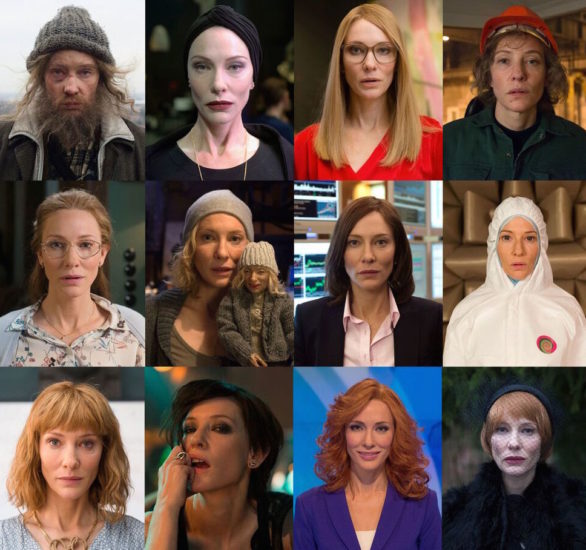
Installation of Julian Rosefeldt’s Manifesto at Park Avenue Armory (Photo by James Ewing)
Julian Rosefeldt: Manifesto
Park Avenue Armory
643 Park Avenue
New York, NY
On view until January 8, 2017
Manifestos don’t age well. This became clear as Cate Blanchett, playing twelve different characters, channeled some of the most notorious artist manifestos of the 20th century in Julian Rosefeldt’s Manifesto at the Park Avenue Armory.
And yet, the installation succeeded not in spite of the manifestos’ irrelevancy, but because of it. The show compellingly reveals the universal drive to replace previous generations’ achievements with the fiery ideals of younger artists. There’s something reassuring about this continual cycle of rejection and innovation, as well as the inspiration viewers can still find within past manifestos.
The installation fills the Armory’s Wade Thompson Drill Hall with a cacophony of voices. Walking into the darkened expanse, the space is lit only by the thirteen enormous hovering screens as Blanchett, in various guises, recites a flurry of manifestos.
Each screen features one distinctive character and a thematically organized set of manifestos. On one screen, she’s a drunk, drug-addled and aggressive rock star slurring about Stridentism. On another, she’s a high-strung Eastern European ballet instructor teaching a group of sparkling, star-covered ballerinas about Fluxus. And on yet another, she’s a Southern mother whispering Claes Oldenburg’s I am for an Art… like a prayer over the dinner table. It’s a schizophrenic tour de force.

All twelve characters in Julian Rosefeldt, Manifesto, 2015 (Courtesy Julian Rosefeldt and VG Bild-Kunst, Bonn)
Both the installation and the films themselves are carefully choreographed. At one point, all the films synch as Blanchett’s characters centrally face the camera. They recite a manifesto in a rushed monotone at various pitches. It not only presents an uncanny sight as twelve Blanchetts appear at once, but it also creates an overwhelming choral sound. This seems to represent the frantic determination and multiplicity of artist manifestos. It is, however, very freaky.
Admittedly, Manifesto is gimmicky. Just the selection of Blanchett, a well-respected Hollywood actress, to inhabit these roles is a crowd-pleasing choice. Similarly, the blockbuster monumentality of its installation also feels overblown and self-indulgent. And yet, so are artist manifestos. It takes a certain level of egomaniacal delusion to write a manifesto and the installation reflects this very drive in its construction.
The production also, perhaps inadvertently, proves how irrelevant these manifestos are by placing them in a real life context. Take, for example, the second film, which follows Blanchett in the role of a homeless man. As he shuffles around abandoned buildings with his dog, the man yells Situationist manifestos by Lucio Fontana and Guy Debord. I felt immediately uncomfortable as he shouted about the definitions of art through a megaphone.
Granted, I don’t think this was Rosefeldt’s intent. In an interview with the Australian Centre for the Moving Image, where the installation premiered, Rosefelt described these manifestos as “not just relevant, but also visionary.”
I disagree. My secondhand embarrassment came from the realization that ranting and raving about art is, on some level, futile and frivolous. My previous encounters with these manifestos were relegated to assigned reading in college classes. Watching a homeless man or a working class mother employed at a garbage incineration plant reading these pretentious art theories, though, confirms just how disengaged much of these ideas are from contemporary life.

Installation of Julian Rosefeldt’s Manifesto at Park Avenue Armory (Photo by James Ewing)
Not only are the manifestos dated now, it seems that some of the manifestos rapidly aged even in their time. This can be seen in the call and response of some of the manifestos in the films. Take, for instance, the film that features Blanchett as a devastated, diva-like widow delivering a eulogy of Dadaist manifestos. She loudly and fervently criticizes Futurism, just as a New York stockbroker performs Futurist manifestos on a nearby screen.
What this successfully reveals is how each generation rejects and replaces the last with their own passionately argued artistic visions. This cycle occurs again and again. There’s something promising watching the march of progress firsthand, especially in the context of Trump’s impending inauguration when it feels like we slid back to the 1930s or at best, 1950s. It’s soothing to see a confirmation that younger generations will appear with new, radical ideas.
And just because they feel old doesn’t mean there aren’t moments in which the manifestos can resonate with contemporary life. For example, the opening scene of the Futurism film reflects the Futurists’ interest in constant movement and machinery. The beginning of the film shows the frenetic energy of a stock trading floor in slow motion as employees move around the room and wildly gesture at their desks. As Blanchett’s broker later explains Futurist philosophy, viewers can see how the Futurists’ embrace of speed and technology is still visible a century later.
The installation ends with Blanchett as an elementary school teacher, lecturing her young students on film manifestos. Here, more than any of the other films, Rosefeldt seems to present his own artist statement. “Steal from anywhere that resonates with inspiration or fuels your imagination,” Blanchett says, delivering Jim Jarmusch’s Golden Rules of Filmmaking. With this, Rosefeldt encourages viewers to take the parts of historical objects and texts they find relevant and make them their own. I left not only yearning for new artist manifestos that address our surreal and nightmarish present, but also, thinking that perhaps, during the next four years, that’s just the advice we need.


Comments on this entry are closed.